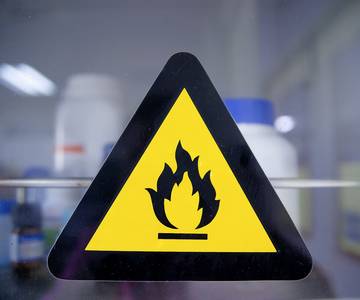
Why Are WHMIS Labels Important?

Any product manufactured with hazardous materials requires a WHMIS label. This labelling requirement notifies the individuals about the inherent risks and dangers. By adhering to the WHMIS system, your staff can take the appropriate material handling measures to ensure workplace safety. Every worker managing sensitive materials or working in hazardous environments should be knowledgeable in WHMIS labels.
According to the Occupational Health and Safety Act (OHSA), employers must provide WHMIS instructions to their workforce. WHMIS training consists of comprehensive courses that help employees to identify the various symbols and understand their meanings. They will learn about each pictogram in-depth, the various types of hazards, along with all the different hazard classes.
Upon completion, the trained individuals will understand how to navigate work environments with hazards highlighted by WHMIS labels. As sensitive products travel from worker to worker, the WHMIS system will play a fundamental role in keeping everyone safe. Let’s discover why WHMIS labels are important to workplaces.
What is WHMIS?

WHMIS is Canada’s hazard communication system. The acronym stands for Workplace Hazardous Materials Information System. WHMIS was created in 1988 to help workers identify hazardous materials used in the workplace. Updated recently, the WHMIS 2015 system corresponds with its similar counterpart, the Globally Harmonized System of Classification and Labelling of Chemicals (GHS).
Using a simple pictogram system, WHMIS defines how any sensitive product should be handled or stored. It is the supplier’s responsibility to label all hazardous products distributed to customers. In addition, employers must ensure there are suitable WHMIS labels for any materials entering the workplace.
For additional information, read about the ten different WHMIS symbols and their meanings.
What are the two types of WHMIS labels?

There are two different types of WHMIS labels: a supplier label and a workplace label. In addition, there is another type known as the laboratory label, occasionally used in special circumstances. Defined by a set of ten pictograms, each WHMIS label indicates the dangers and precautions associated with the marked products.
A WHMIS supplier label comes from the manufacturer. The supplier label is provided in English or French. It contains six critical pieces of information:
- A product’s identification
- Pictogram
- Signal word
- Hazard statement
- Precautionary statement
- Supplier identification
A WHMIS workplace label is used when the supplier label has been damaged or removed. The WHMIS workplace label is required when a product transfers from one container to another. Unlike a supplier label, the workplace label does not need to include as much information. Its data is limited to:
- Product name
- Safe handling information
- Reference to Material Safety Data Sheet (MSDS)
The WHMIS laboratory label is only applied when lab supplies are transferred between containers. This label is used as an aid to identify laboratory samples in case there are possible unknown hazards.
Why are WHMIS labels important?

WHMIS labels are important because workplaces need a standardized method to identify hazardous materials. The WHMIS system assigns responsibilities to both the suppliers and the employers to classify any dangerous hazards. All workplaces become safer to navigate with WHMIS labels, which decrease material handling risks and provide instructions on protective measures.
A WHMIS label indicates when there are physical or toxic hazards associated with any sensitive materials. Without these particular labels, not everybody would be aware of the dangers involved in certain products. They might unknowingly endanger their health in handling an item that fails to display its risks. Fortunately, the WHMIS labels ensure that workplaces adhere to the necessary health and safety standards.
What is the purpose of WHMIS labels?

WHMIS labels serve numerous purposes in the workplace. The labels can guide the material handling and storage processes, allowing workers to manage each product with care. For example, an item labelled with the ‘compressed gas’ symbol means that it relies on pressure. As such, workers will handle the materials carefully without puncturing the exterior. Furthermore, they’ll know to store the products inside a temperature-controlled setting.
Similarly, other WHMIS labels come with warnings on how to approach certain products. Workers will know to avoid placing flammable materials (highlighted by the ‘flame’ symbol) near fires or sources of ignition. They will also take extreme care of any poisonous or infectious materials, denoted by the ‘corrosion’ and ‘skull and crossbones’ symbols respectively.
WHMIS and Material Safety Data Sheet (MSDS)

MSDS stands for Material Safety Data Sheet. The MSDS sheets contain more information on hazardous materials associated with a WHMIS label. Consider it a detailed version of a WHMIS label, usually outlining more data about the fire, reactivity, or environmental risks. MSDS sheets are sometimes known as Safety Data Sheets (SDS).
The MSDS sheets may contain the following information:
- Product identification and use
- Hazardous ingredients
- Physical data
- Fire and explosion data
- Reactivity data
- Toxicological properties
- Preventative and first aid measures
The first aid measures are one of the most important information included in the MSDS sheet. These measures will explain how to treat a worker exposed to hazardous materials. Those who have completed CPR and first aid training may consult the MSDS for the best course of action. Following the MSDS data allows a first responder to act quickly upon arrival and treat the problem efficiently.

